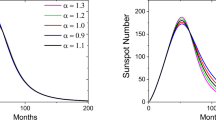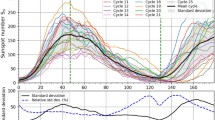Abstract
The sunspot number (SSN) is an important – albeit nuanced – parameter that can be used as an indirect measure of solar activity. Predictions of upcoming active intervals, including the peak and timing of solar maximum, can have important implications for space-weather planning. Forecasts for the strength of Solar Cycle 25 have varied considerably, from being very weak to one of the strongest cycles in recorded history. In this study, we develop a novel quantile-based superposed-epoch analysis that currently predicts that Solar Cycle 25 will be very modest (within the lowest 25th percentile of all numbered cycles), with a monthly averaged (13-month average) peak of ≈ 130 (110) likely occurring in December 2024. We validate the model by performing retrospective forecasts (hindcasts) for the previous 24 cycles, finding that it outperforms the baseline (reference) model (the “average cycle”) 75% of the time.







Similar content being viewed by others
Data Availability
All data analysed in this study can be downloaded from www.sidc.be/silso/datafiles. However, for convenience, and to the extent that these data may change, we are also making the data available with the source code at the following GitHub repository: github.com/predsci/QSEA-ssn-prediction.
Code Availability
All code necessary to reproduce the figures and analysis presented here is being made available through the following GitHub repository: github.com/predsci/QSEA-ssn-prediction.
Change history
17 June 2023
The original online version of this article was revised to incorporate the editor’s correction that were accidentally missed before online publication.
15 June 2023
A Correction to this paper has been published: https://doi.org/10.1007/s11207-023-02181-y
References
Ahluwalia, H.S.: 2022, Forecast for sunspot Cycle 25 activity. Adv. Space Res. 69, 794. DOI. ADS.
Boykin, E., Richards, T.: 1966, Application of the Lincoln McNish Technique to the Prediction of the Remainder of the Twentieth Sunspot Cycle. Technical report, Technical Memorandum 54/30-89, Lockheed Missiles and Space Company, Huntsville.
Cameron, R., Schüssler, M.: 2008, A robust correlation between growth rate and amplitude of solar cycles: consequences for prediction methods. Astrophys. J. 685, 1291. DOI. ADS.
Carrasco, V.M.S., Vaquero, J.M.: 2022, An early assessment of the forecast by the Solar Cycle 25 prediction panel. Res. Notes Am. Astron. Soc. 6, 121. DOI. ADS.
Clette, F., Svalgaard, L., Vaquero, J.M., Cliver, E.W.: 2014, Revisiting the Sunspot Number. Space Sci. Rev. 186, 35. DOI. ADS.
Clette, F., Lefèvre, L., Chatzistergos, T., Hayakawa, H., Carrasco, V.M.S., Arlt, R., Cliver, E.W., Dudok de Wit, T., Friedli, T.K., Karachik, N., Kopp, G., Lockwood, M., Mathieu, S., Muñoz-Jaramillo, A., Owens, M., Pesnell, D., Pevtsov, A., Svalgaard, L., Usoskin, I.G., van Driel-Gesztelyi, L., Vaquero, J.M.: 2023, Recalibration of the sunspot-number: status report. Solar Phys. 298, 44. DOI. ADS.
Gleissberg, W.: 1939, A long-periodic fluctuation of the sun-spot numbers. Observatory 62, 158. ADS.
Gnevyshev, M., Ohl, A.: 1948, On the 22-year cycle of solar activity. Astron. Zh. 25, 18.
Hanslmeier, A., Denkmayr, K., Weiss, P.: 1999, Longterm prediction of solar activity using the combined method. Solar Phys. 184, 213. DOI. ADS.
Hathaway, D.H.: 2015, The solar cycle. Liv. Rev. Solar Phys. 12, 4. DOI. ADS.
Hathaway, D.H., Wilson, R.M., Reichmann, E.J.: 1994, The shape of the sunspot cycle. Solar Phys. 151, 177. DOI. ADS.
Kumar, P., Biswas, A., Karak, B.B.: 2022, Physical link of the polar field buildup with the Waldmeier effect broadens the scope of early solar cycle prediction: Cycle 25 is likely to be slightly stronger than Cycle 24. Mon. Not. Roy. Astron. Soc. 513, L112. DOI. ADS.
McIntosh, S.W., Chapman, S., Leamon, R.J., Egeland, R., Watkins, N.W.: 2020, Overlapping magnetic activity cycles and the sunspot number: forecasting sunspot Cycle 25 amplitude. Solar Phys. 295, 163. DOI. ADS.
McNish, A.G., Lincoln, J.V.: 1949, Prediction of sunspot numbers. Eos Trans. AGU 30, 673. DOI. ADS.
Meadows, A.J.: 1970, Review of publications- early solar physics. J. Roy. Astron. Soc. Can. 64, 326. ADS.
Nandy, D.: 2021, Progress in solar cycle predictions: sunspot Cycles 24-25 in perspective. Solar Phys. 296, 54. DOI. ADS.
Niehuss, K., Euler, H. Jr, Vaughan, W.W.: 1996, Statistical technique for intermediate and long-range estimation of 13-month smoothed solar flux and geomagnetic index. Technical report, NASA, Huntsville.
Pesnell, W.D.: 2020, Lessons learned from predictions of Solar Cycle 24. J. Space Weather Space Clim. 10, 60. DOI. ADS.
Petrova, E., Podladchikova, T., Veronig, A.M., Lemmens, S., Virgili, B.B., Flohrer, T.: 2021, Medium-term predictions of F10. 7 and F30 cm solar radio flux with the adaptive kalman filter. Astrophys. J. Suppl. Ser. 254, 9.
Petrovay, K.: 2020, Solar cycle prediction. Liv. Rev. Solar Phys. 17, 2. DOI. ADS.
Phillips, T.: 2022, The Termination Event has Arrived. spaceweatherarchive.com/2022/02/25/the-termination-event-has-arrived/.
Podladchikova, T., Jain, S., Veronig, A.M., Sutyrina, O., Dumbović, M., Clette, F., Pötzi, W.: 2022, Maximal growth rate of the ascending phase of a sunspot cycle for predicting its amplitude. Astron. Astrophys. 663, A88. DOI. ADS.
Prasad, A., Roy, S., Sarkar, A., Chandra Panja, S., Narayan Patra, S.: 2022, Prediction of solar Cycle 25 using deep learning based long short-term memory forecasting technique. Adv. Space Res. 69, 798. DOI. ADS.
Pultarova, T.: 2022, NASA’s solar forecast is turning out to be wrong. This team’s model is still on track. www.space.com/why-solar-weather-forecast-doesnt-work.
Riley, P., Caplan, R.M., Downs, C., Linker, J.A., Lionello, R.: 2022, Comparing and contrasting the properties of the inner heliosphere for the three most recent solar minima. J. Geophys. Res. 127, e30261. DOI. ADS.
Shove, D.: 1986, Solar activity and cyclicity since AD 300 and future sunspot cycles. In: Simon, P.A., Heckman, G., Shea, M.A. (eds.) Solar-Terrestrial Predictions, NOAA, Boulder. 58. ADS.
Suggs, R.J., Euler, H., Smith, S.: 2013, Future Solar Activity Estimates for Use in Prediction of Space Environmental Effects on Spacecraft Orbital Lifetime and Performance, NASA Marshall Space Flight Center, Huntsville, Alabama.
Waldmeier, M.: 1971, The asymmetry of solar activity in the years 1959 – 1969. Solar Phys. 20, 332. DOI. ADS.
Wilson, R.M.: 1988, On the long-term secular increase in sunspot number. Solar Phys. 115, 397. DOI. ADS.
Wilson, R.M.: 1992, An early estimate for the size of SOLAR-CYCLE-23. Solar Phys. 140, 181. DOI. ADS.
Funding
The author gratefully acknowledges support from NASA (80NSSC18K0100, NNX16AG86G, 80NSSC18K1129, 80NSSC18K0101, 80NSSC20K1285, 80NSSC18K1201, and NNN06AA01C), NOAA (NA18NWS4680081), and the US Air Force (FA9550-15-C-0001).
Author information
Authors and Affiliations
Contributions
P. Riley conceived of the study, performed all analyses, and wrote and reviewed the manuscript.
Corresponding author
Ethics declarations
Competing interests
The authors declare no competing interests.
Additional information
Publisher’s Note
Springer Nature remains neutral with regard to jurisdictional claims in published maps and institutional affiliations.
The original online version of this article was revised to incorporate the editor’s correction that were accidentally missed before online publication.
Rights and permissions
Springer Nature or its licensor (e.g. a society or other partner) holds exclusive rights to this article under a publishing agreement with the author(s) or other rightsholder(s); author self-archiving of the accepted manuscript version of this article is solely governed by the terms of such publishing agreement and applicable law.
About this article
Cite this article
Riley, P. On the Strength and Duration of Solar Cycle 25: A Novel Quantile-Based Superposed-Epoch Analysis. Sol Phys 298, 66 (2023). https://doi.org/10.1007/s11207-023-02165-y
Received:
Accepted:
Published:
DOI: https://doi.org/10.1007/s11207-023-02165-y




